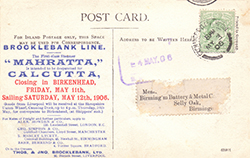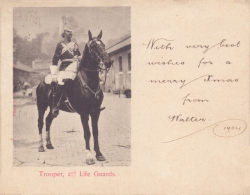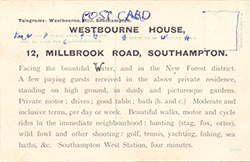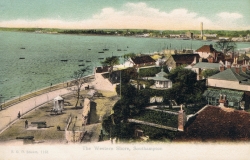Revision 3 of the checklist
Today I have updated the downloadable checklist to revision 3. This latest version contains nearly 50 amendments to the first version that was released in 2018.
Google Street View
The site has supported map locations since day one, but nothing beats looking at a postcard's location from the same spot today. A recent enhancement to the site allows this, showing the approximate view point on a Google Street View. Finding the correct view requires manually checking unfortunately, so adding the views to all the cards is likely to be a long process.
Some cards have the view added already, and for these cards the map can be switched between the top-down map view and the Street View by toggling the buttons above the map.
A Stuart Commercial Card
The printing on the rear of this card this card advertises Westbourne House hotel on Millbrook Road. Those familiar with the Millbrook area today will not recognise the description on the card. The original card has an arrow drawn on the horizon, presumably pointing to the location of the hotel!
A Stuart Commercial Card
 This interesting advert has been printed on the rear of this card, a good example of Stuart's cards being used for commercial purposes. The voyage to Calcutta advertised takes place on the ship that is the subject of the postcard.
This interesting advert has been printed on the rear of this card, a good example of Stuart's cards being used for commercial purposes. The voyage to Calcutta advertised takes place on the ship that is the subject of the postcard.
See all cards with the same number
Stuart released many versions of the same card with different numbers (indeed, sometimes mis-numbering different cards with the same number). Now you can see all the cards having the same number on one page.
For example card 872.
This page can be accessed by clicking the link on the card number from the main card page, for example here.
The great 868 mis-number - Updated
It seems likely that the 868 mis-number is not a mis-number at all, but that 868 was in fact Stuart's telephone number. There are one or two points in favour of this theory.
- The 868 cards all seem to be relatively late (post 1915 or so), and of lower quality British manufacture.
- The ones I have seen seem to be reprints of earlier cards.
- Southampton 868 sounds like a phone number.
Unfortunately I have been unable to prove this to be the case one way or the other. Southampton Library has a collection of telephone directories, but they do not seem to go back quite far enough and none list Stuart.
Thanks to Edward for the updated information.
Some examples of 868 can be found here.
Gregory Military Series

I recently came across this card, published by Gregory & Co. It seems that Gregory & Co published a series of cards, of military subjects, all featuring Stuart photos as used by Stuart on his own early military cards.
I have seen several of these cards and would be very interested to see any others that people may be aware of, or of any other information about Gregory & Co.
Liliywhites
Lilywhites were a well known publisher and printer of postcards based near Halifax. Stuart used them to publish at least some of his cards. They all appear to be sepia-gloss real photo cards.
I have identified the cards available on this site that were produced by Lilywhites for Stuart, the can be found here. Any additions or corrections welcome as usual.
Updated checklist
I have released revision 2 of the checklist, this version fills in some gaps and corrects some mistakes. A full list of the changes can be found in the checklist itself.
The checklist can be downloaded here.
As usual and comments, corrections or revisions to info@fgo-stuart.co.uk please.
New checklist available
A complete checklist of all of F.G.O Stuarts known cards is now available to download here. This draws upon the years of work the late Jack Foley and others put into collating such a comprehensive list.
Please download the checklist and send any corrections or additions to info@fgo-stuart.co.uk.
The great 868 mis-number.
I have come across two cards, both British printed issues of Lyndhurst subjects, both mis-numbered 868 on the rear. I can only assume that these were from the same batch and the printer printed the wrong number on several different cards. I wonder if there are any more out there.
Card Number 1782 Gap filled in checklist
Thanks to the kindness of a site visitor, I have been able to fill in a gap in the checklist. See card 1782 - East Southsea Beach

Portrait Format!
Finally I have fixed the site bug that was preventing me from uploading some of Stuart's portrait aspect cards. Stuart issued many cards in the vertical, portrait orientation, including some of his earliest military subjects.
I will start uploading the backlog I have built up which will help fill in a few gaps in the collection.
New Card Variation
I have recently acquired a copy of this card depicting Southampton Town Quay:

with red lettering, a variant not listed by Jack Foley in his checklist.
See the card here.
New Card Discovered!
Thanks to a kind user for providing a sample of card 1599, a view of Boscombe Beach. This card was previously unknown as it was left blank on Jack Foley's generally comprehensive checklist and it is always nice to fill in a blank.
The online checklist based on Jack's list can be found here.

See the card page here.
Help please
I currently have 35 or so images for which I have been unable to pinpoint a location. Please take a look at the unknown location tag and let me know if you can locate any of them!
Announcing Then & Now
Then & Now scenes seem to be the popular thing nowadays, perhaps spurred on by the resurgence of interest in heritage.
I thought it would be interesting to view some of the scenes Stuart took as they look today so, for certain images, I've added a feature that allows fading between Stuart's shots and ones of a similar view that I've taken recently. These are a mixed bag - in some cases it's difficult to recreate Stuart's original view-point, he seemingly took a lot of shots from a very high position, perhaps on some kind of platform, and in some cases modern developments present other challenges in finding or getting to the right spot. I have also not quite managed to narrow down the kind of focal length that he used, most of the pictures seem quite wide-angle but I can't quite get he persepctive right. More practise needed I think!
I'll be adding more views as and when I can, I already have a few more in the bag that need processing. In the meantime the existing images are all under the Then & Now tag.
Previously unknown F.G.O Stuart Postcard - 523 Bitterne
I have acquired this card, number 523 titled 'Bitterne'. This card was not listed on the Jack Foley checklist nor on the later published addendum that I am using.
Perhaps this will be a new addition for other collectors too,
Updated Biography
I've updated the site slightly to make Stuart's biography easier to find. I've also updated the biography itself to reflect the latest research I have done and to fill in some missing details. If you know of anything I've left out then please let me know. I'm still looking for more evidence of Stuart's activities in Aberdeen before he moved to London as well as from during his time in London.
The biography can be found here.
Minor update to map
Hello all. I've performed a minor update to the map so that the map markers are clustered. This makes it easier to see where the concentrations of images are and clearly shows that most of the cards Stuart issued were of images taken in the Southampton area. Check it out on the map page.
I've been steadily adding cards as time permits, at the moment I still have about 150 to add, including all the portrait orientated ones which I have not quire worked out how to deal with yet!
Finally, a checklist!
Many have asked so, finally, I am happy to announce the addition of a checklist to the site! This is based on an earlier list compiled by Jack Foley (available at Southampton Library) and includes any additions and corrections I have made over the years. Note that, while the list is as definitive as it can be to my knowledge, there are a number of missing items and I have not quite got round to transcribing all the various publishers etc yet.
- The list is available here as an online Google Doc.
- The list is also available for download as an Excel spreadsheet here.
I will shortly be adding a page to the site with these links so that they are more obvious.
I'm of course happy to accept any contributions or corrections. Simply contact me.
Happy collecting.
Pictures of Stuart's Houses in Southampton
I am in the process of researching the life of F.G.O, Stuart and have expanded the biography page accordingly. Check it out for pictures of the houses that Stuart occupied during his time in Southampton. Sadly one of his properties was destroyed during the war but the others survive. I have discovered that Stuart occupied a building at Bedford place for several years before moving in to Cromwell Road. He also is listed at 'West Marlands' in the 1887 Steven's Street Directory but I have not discovered the exact location. Confusingly the 1887 Kelly's directory lists him at Cromwell Road so he can't have been at West Marlands for more than a few months. If you know any further details of this or anything else about Stuart, his business or any of his photographs then please let me know.
I have been using the excellent resources at PortCities to research this, as well as the special collections at Southampton Central Library.
New design!
I've redesigned the site so that it's cleaner, faster and easier to browse.
I was never really satisfied with the previous design, the homepage in particular was cluttered and clunky. The new design is modern and fresh and really shows off Stuart's postcards.
I hope you like it.
A minor update
I've taken the time to make a couple of minor enhancements:
- The links to the map on each card page now center the map on the card location and zoom in a bit.
- I've added example links for many of the cards discussed in the collecting section.
I've also been adding a steady trickle of cards to the site. I'm on the way to 400 cards now which is great as this is starting to become a representative sample of Stuart's work.
Collecting Stuart's Cards
I have added a section on collecting Stuart cards. This gives some details on the various series of cards Stuart published as well as some information on the various variations of cards that can be found.
If I have got anything wrong or if you have anything to add then please let me know.
I'm also working on completing a checklist (based on the late notable collector Jack Foley's list) which will detail all of the known Stuart cards and variations. This is quite a bit of work but i hope to have it completed soon.
Card 300!
Today I added the 300th card to the site.
Stuart published over 2000 cards so there is still a way to go to get them all. I have a batch of another 30 to upload and plenty more to scan so there is no immediate end in sight!
Help me out!
In an attempt to clear my backlog, I've worked through and uploaded over 30 new cards in the last few days.
While I'm able to geo-locate most of the cards, a few are proving a bit more tricky. I've tagged all of these with Unknown location, if you can help identify the exact location of these please let me know!
Any help would be much appreciated.
Some new cards!
I have finally got around to adding some new cards! Primarily of the Isle of Wight and Bournemouth. I think this and this are my favourites, mainly because I walk past them most days.
Saving A Century Exhibition At Southampton Guildhall
I've just received some information about a forthcoming exhibition at Southampton Guildhall this December and January.
The Victorian Society’s photographic exhibition Saving a Century, curated by architectural historian Gavin Stamp will be on show from 3rd December to 11th January, free of charge.
It looks awesome and I'll certainly be popping in!
Here are some details:
VICTORIAN BUILDINGS LOST BEFORE 1958 – A photographic survey of some of the best Victorian buildings destroyed in the first half of the twentieth century, among them Crystal Palace (burnt down 30th November 1936), Trentham Hall, Staffordshire (abandoned by the 4th Duke of Sutherland in 1906 and demolished five years later) and Queen’s Park Church, Glasgow (Scotland’s worst architectural loss of the Second World War).
THE FOUNDATION OF THE VICTORIAN SOCIETY – Photographs and material from the opening meetings of the Society. Early members included architect Hugh Casson, architectural historian Christopher Hussey, Sir Nikolaus Pevsner and Sir John Betjeman.
THE EUSTON MURDER AND OTHER CASES – Photographs and text documenting the bitter battle for the Euston Arch, as well some of the Victorian Society’s other early defeats. There were early victories too, among them the Oxford University Museum, proposed for demolition in 1961 to make way for new science buildings. The Victorian Society also succeeded in getting the Broad Street Building of Balliol College listed, after it was threatened with a re-build in 1963.
VICTORY IN WHITEHALL – Photographs charting the heroic, ten-year campaign against plans to demolish much of the historic square mile, including nearly every building south of Downing Street and Richmond Terrace. Sir George Gilbert Scott’s Foreign Office, Richard Norman Shaw’s New Scotland Yard and Middlesex Guildhall in Parliament Square were among the buildings proposed for demolition.
PLACES OF WORSHIP – A photographic survey of some of the historic churches, chapels and synagogues with which the Victorian Society has been involved. As churches are exempt from the secular planning system, it can be particularly difficult to guard them against insensitive change. With falling attendance figures and a growing number of redundant places of worship, the future of our best churches is one of the biggest challenges facing heritage campaigners today.
RAILWAY BUILDINGS – Photographs of some of the key buildings the Victorian Society fought for, as the closure of many branch and other railway lines resulted in the redundancy of numerous stations, bridges and viaducts. That many pioneering and magnificent railway structures, such as St Pancras Station, survive today, often still in use, is very much owing to the efforts of the Society.
IRON, GLASS & STONE – Photographs of some of the most innovative nineteenth century buildings, among them Clevedon Pier, Islington’s Royal Agricultural Hall and Bradford’s Kirkgate Market, for which the Victorian Society has fought.
THE FUNCTIONAL TRADITION – Photographs of some of the most impressive industrial buildings for which the Society has fought. With the decline of the traditional industries of the North of England after the Second World War, many mills and warehouses became redundant while many Northern towns and cities became ashamed of their Victorian industrial legacy and anxious to replace it with something new. The Victorian Society, along with bodies such as SAVE Britain’s Heritage, argued that nineteenth century industrial buildings were evocative and substantial structures which were not only of historical importance but capable of gainful re-use.
THE PURPLE OF COMMERCE – Photographs of some of the most significant Victorian commercial buildings to have come under threat in the last fifty years. Built partly as self-advertisements and partly to inspire confidence, these ambitious and substantial banks, offices and warehouses too often fall victim to redevelopment schemes.
COUNTRY HOUSES – Photographs of some of the grandest country houses to have been the subject of Victorian Society campaigns, among them Shadwell Park, Tyntesfield and Highcliffe Castle. Rendered redundant by social and cultural changes, some of the most famous large houses were demolished between the wars while many more disappeared in the 1950s.
DOMESTIC ARCHITECTURE – A collection of photographs of some of the Victorian villas and terraced houses for which the Victorian Society has fought. Often extravagant and fanciful buildings, these buildings are regularly demolished to allow higher density developments in their grounds or make way for flats.
PUBLIC INSTITUTIONS – A photographic survey of some of the best municipal buildings that have been saved or lost. Physical embodiments of the Victorians’ strong sense of civic pride and duty, many of these splendid town halls, libraries, swimming pools, museums, art galleries and post offices still add much to the rich character of British towns and cities today.
BEACONS OF THE FUTURE – A survey of some of the Society’s most recent campaigns, focusing on the battle for Victorian schools and swimming pools. Among the battles highlighted are the protest and funeral for Bonner School, the Public Inquiry for Easington Colliery School and the local campaign for the Moseley Road Baths in Birmingham.
THE VICTORIANS VICTORIOUS – Photographs of some of the most notable Victorian buildings used and valued today.
For more information please contact Steve Roman on 0161 434 2908 or email steve.roman@phonecoop.coop Or Mike Barnes on 020 8747 5897 or email mike@victoriansociety.org.uk
A New Site Design!
I haven't updated the blog in a while (that's what a new job and a new baby does for you!) but recently I have completely rebuilt the site. This was a bit of an academic excercise, I wanted to explore some new technologies so took the plunge!
After some struggles I've got it all working and hope to add some further features to it over the next few weeks and months.
I still have an enormous backlog of cards to upload. I have managed to scan pretty much all of them over the last few months so just need to sit down and upload them all. This is a suprisingly long-winded process as I have to geo-code them all so that they show on the map.
In the meantime all the old cards are still here. Check out the Southampton or New Forest tags to get started!
Another long stretch...
I have been adding images on an ad-hoc basis, I've just added three of Brighton and three of Stonehenge. Both illustrate just how much things have changed in the last hundred years or so!
Christmas update!
I see that I haven't posted any images since September! I've uploaded a few new ones.
Minor Update
I've performed a number of minor updates to the site. The most visible of which is that the search box will now 'auto complete' entries; for example try 'High Street'....
Also added a few more images and expanded the Photos menu to include Portsmouth and Bournemouth.
New images
It's been a little while but I've just added a batch of images for Bournemouth and Portsmouth.
New feature - Related Photos
I've just added a feature to the site that will display photos related to the currently viewed photo. Up to 4 related photos will display alongside the main image. The site uses the tags applied to each photo to work out which other photos are similar.
100 images
I've just uploaded another batch of images which breaks the 100 image mark (108 to be precise).
Map
I've added a map which plots the location of each image. Clicking on the pin will show the details of the image and link to the full image page.
Note that only images that have been geotagged will show on the map.
It's an interesting alternative way of browsing the image collection.
Image Ordering
Noticed this wasn't working so fixed it.
Updates
I've been steadily adding images to the site (nearly 70 and plenty more still to do!). I've also updated the design of the site and fixed one or two bugs.
Recently I took a number of photos for the Then and Now series and will be adding these soon.
More Photos
I've added a batch of 8 photos. all geocoded. That brings the total number of photos on the site to 58.
Latest update
I've now geocoded most of the photos on the site with a latitude and longitude. Photos that have been geocoded will show a Google maps icon, clicking the icon will take you to the location of the photo on Google Maps.
I've also added the first in a series of 'Then and Now' stories. The intention of these stories is to take some of the best Stuart images and try to create a modern version of them. It's a real challenge to find the exact spot from which Stuart took his photos but the results are fascinating and really emphasise the changes of the last 100 years.
New image and story added
I've uploaded a new image which is another version of this image.
I find the images on these cards particularly fascinating as they offer a unique view of old Southampton, the accompanying story gives a little detail of some of the most interesting elements.
I've also scanned and prepped a number more images ready for upload shortly.
Further work has gone into the development of the site; a number of bugs have been ironed out and I've added some code that highlights tags within the text of a story.
Email address fixed and links added!
I've just noticed that the email address I provided (info@fgo-stuart.co.uk) was not working. Apologies if you've attempted to use this and have received an error, please do resend the message.
I've also added a links page. If you would like me to add a link to your (related) site then please drop me a line.
Hello World!
The site is up and running - hooray!
As a history buff and IT geek looking for a project, I decided it would be a good idea to build a resource dedicated to depicting the work of Victorian/Edwardian photographer F.G.O. Stuart.
The site is broken into 3 main sections:
- Photos: Scans of old postcards.
- Stories: Stories will go into a bit more detail of the history depicted in the postcards scenes.
- Tags: Each Photo and Story will be tagged with appropriate keywords, facilitating searching and browsing of the site.
The site has been launched with approx 50 images and a couple of stories. I have several hundred more images to scan and will be added more content to the site on a weekly basis; I will also update the rather rudimentary design (at least, that's the plan).
For those who are interested, this is my first ASP.Net project and has been built using version 4 of the .Net framework, jQuery, AJAX and the Entity Framework.
- April 2020
- March 2019
- October 2018
- July 2018
- June 2018
- April 2018
- July 2017
- June 2017
- February 2017
- January 2017
- May 2016
- March 2015
- January 2015
- September 2014
- July 2014
- March 2014
- February 2014
- November 2013
- July 2013
- May 2013
- March 2013
- February 2013
- January 2013
- November 2012
- March 2012
- December 2011
- September 2011
- August 2011
- July 2011
- June 2011
- May 2011




